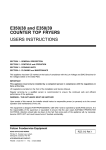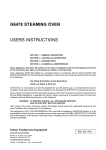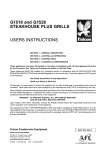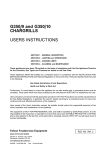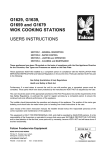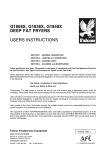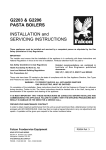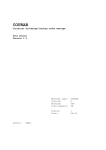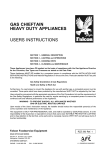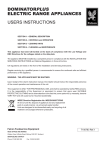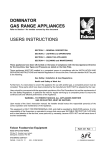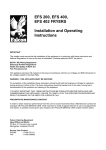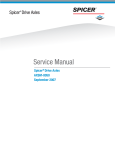Download G2101 OTC!User Manual
Transcript
G2101 OTC DOMINATOR RANGE USERS INSTRUCTIONS SECTION 1 - GENERAL DESCRIPTION SECTION 2 - LIGHTING and OPERATIONS SECTION 3 - USING THE APPLIANCE SECTION 4 - CLEANING and MAINTENANCE The appliance has been CE-marked on the basis of compliance with the Gas Appliance Directive, EMC and Low Voltage Directive for the Countries, Gas Types, Pressures and Voltages as stated on the Data Plate. The appliance MUST BE installed by a competent person in compliance with the INSTALLATION AND SERVICING INSTRUCTIONS and National Regulations in force at the time. Particular attention MUST be paid to the following: Gas Safety (Installation & Use) Regulations Health and Safety at Work Act Furthermore, if a need arises to convert the appliance for use with another gas, a competent person must be consulted. Those parts which have been protected by the manufacturer MUST NOT be adjusted by the User. Users should be conversant with the appropriate provisions of the Fire Precautions Act and the requirements of the Gas Safety Regulations. in particular the need for regular servicing by a competent person to ensure the continued safe and efficient performance of the unit. WARNING - TO PREVENT SHOCKS, THIS APPLIANCES MUST BE EARTHED Upon receipt of the User's Instruction manual, the installer should instruct the responsible person(s) of the correct operation and maintenance of the unit. This equipment is ONLY FOR PROFESSIONAL USE, and shall be operated by QUALIFIED persons. It is the responsibility of the Supervisor or equivalent to ensure that users wear SUITABLE PROTECTIVE CLOTHING and to draw attention to the fact that, some parts will, by necessity, become VERY HOT and will cause burns if touched accidentally. Falcon Foodservice Equipment HEAD OFFICE AND WORKS PO Box 37, Foundry Loan, Larbert. Stirlingshire. Scotland. FK5 4PL AFE SERVICE CONTACT - PHONE - 01438 751 111 FAX - 01438 369 900 RZZ 336 Ref.1 SECTION 1 - GENERAL DESCRIPTION SECTION 2 - LIGHTING and OPERATIONS The G2101 OTC is a dual fuel range with gas six Open Top burner open top hob and electric fan convection oven. Hob burners are fitted with individual flame failure devices which shut off the gas supply to burners should the flames be interrupted. GAS CONTROLS All gas taps are safety type and are fitted with flame failure detection and HIGH and LOW settings. Tap operation is illustrated in Figure 1. Off position Figure 1 1. Depress and turn control knob to full flame position. 2. Light burner using a taper or a match. Continue to press knob in for 20 seconds before release. 3. The burner should remain lit. If burner goes out, return to Step 1 and repeat ignition procedure. 4. Having lit burner, turn control knob to required setting. To Shut Off an Open Top Burner Turn control knob to off position. Oven Low flame setting (Simmer) 1. Ensure main supply is on. Red neon should light. 2. Turn control knob (see Figure 3) clockwise to desired setting. Amber neon will light and remain lit Maximum flame until temperature is reached. setting (High) 3. Do not leave doors open for longer than is necessary to load or unload oven. Open Top Gas Tap Each tap is identified with it's corresponding burner. (See Figure 2) SECTION 3 - COOKING HINTS Open Top Open top burners rated at 4.5kW nett. Figure 2 Boost burners rated at 5.3kW nett. Positions are indicated in Figure 4. Rear Burner Front Burner ELECTRIC CONTROLS The electric control consists of a combined fan switch and thermostat. Two neons, one RED, one AMBER indicate Mains ON and Oven Heat ON respectively. The control knob is identified by the symbols shown in Figure 3 below. Figure 3 Figure 4 The pan supports will safely accommodate pans from 125mm diameter. It is recommended however, that pans larger than 300mm diameter be heated upon the rear burners. Oven Temperature is automatically controlled by thermostat. The cooking chart gives thermostat settings and time required but for best performance, follow these instructions. Grid Shelves Mains ON INDICATOR Thermostat control knob and heat ON indicator Space at least one runner apart (for example, use positions 1, 3 & 5). Push shelves back into oven until shelf stops hit front runners. Tray Size A cake tray up to 650mm x 530mm (Gastronorm 2/1) may be used on each shelf. Single trays or dishes should be placed centrally. Trays must not be allowed to overhang the shelf in any direction since this will adversely affect the heat circulation. Pre-heat Time Allow at least 15 minutes from switching oven on from cold before loading with food. Insert dish quickly and close doors firmly. The oven is fan assisted. Cooking temperatures should be lower than those of a conventional oven. Cooking times may also differ. Cooking times are dependant upon the following: Pre-heat Temperature Food Temperature (e.g. frozen, chilled or ambient) Shelf Load Oven Load Size and weight of food Personal Preference Five shelf positions are available. Three shelves are supplied. When using 3 shelves, we recommend that Positions 1, 3 and 5 be used. Chef's Tips Always pre-heat the oven to the desired temperature. Use the appropriate trays. Do not over load the oven. Place the food upon the shelves centrally. Avoid opening the oven doors during the cooking process. When removing food from the oven, ensure that the doors are fully open. Cooking Chart The following information is based upon full loads positioned on Shelves 1, 3 and 5. This information is provided as guidance only and all figures are approximate. Temperature (oC) 100 Time (minutes) 180 Shortbread Biscuits 140 55 Croissants 170 25 Apple Turnovers 180 35 Fairy Cakes 200 15 Chickens 200 52 Vol-au-Vent Cases 210 18 Chicken Pies 210 33 Fruit Scones 220 13 Yorkshire Puddings 220 30 Food Product Meringue Shells SECTION 4 - CLEANING THE APPLIANCE General BEFORE ANY CLEANING OPERATION, ISOLATE ELECTRICITY AT THE MAIN SWITCH. THE APPLIANCE MUST NEVER BE CLEANED WITH A JET OF WATER OR BE STEAMCLEANED. Clean with soapy water as often as possible, rinse and dry. Grease should be removed with fine steel wool or proprietary cleaning pads. Nylon pan scrubbers should be used with care, especially when new as they may scratch the enamelled surfaces. Before removing any parts, notice carefully how the parts are arranged and replace them in the same positions after cleaning. Cleaning the Hob 4. Clean any spillage from the burner base, ensuring all food and cleaning material debris is removed. Dry burner base thoroughly, taking care not to damage the flame sensor. Flame Sensor Figure 6 Important Do not allow any spillage or cleaning material debris enter large hole in burner base. This may cause blockage of the gas injector. The following instructions should be followed when : a) A spillage has occurred on burner. b) Burner fails to light or stay alight. c) At the end of each day or cooking period. Caution Parts may be hot therefore protection to avoid burns should be used. 1. Remove pan support. 2. Remove burner head and bezel by lifting upward. Figure 7 5. Replace burner head and aluminium bezel upon burner base and ensure that head location pips sit within notches in burner bezel. When burner head is properly located, it will not rotate. Pips Figure 4 3. Thoroughly clean with soap and water. Ensure that all burner ports are clean and free from food or cleaning material debris. Important Stubborn debris lodged in the ports (See Figure 5) may be removed using a non-metallic implement such as a cocktail stick. The slots in the base should be freed of debris using a soft brush. Dry the burner with a lint-free cloth and blow through the ports to ensure there is no blockage. Figure 5 Ports Slots Notch Figure 8 6. Light burner to check that it operates correctly. Note This process should be followed prior to calling for a Service Engineer. Failure due to lack of proper cleaning is not covered by warranty.




